【核心素养目标】Unit 1 Encyclopaedias Period 3 Grammar 课件
文档属性
| 名称 | 【核心素养目标】Unit 1 Encyclopaedias Period 3 Grammar 课件 | 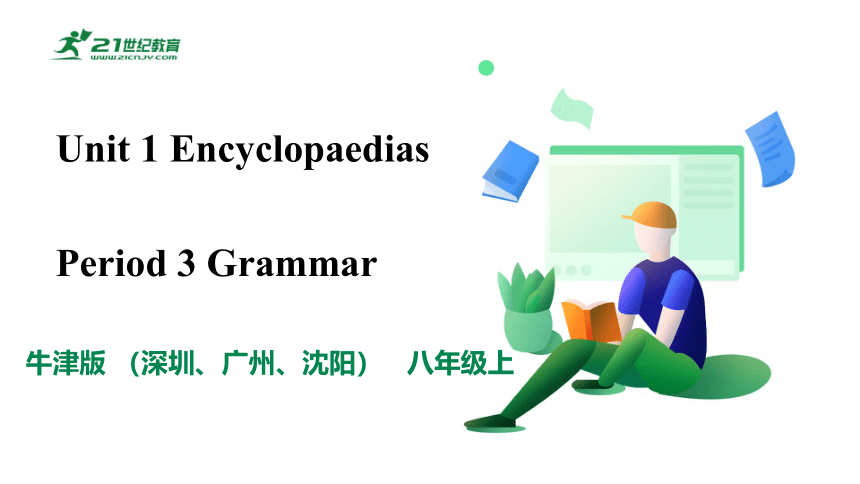 | |
| 格式 | pptx | ||
| 文件大小 | 7.5MB | ||
| 资源类型 | 试卷 | ||
| 版本资源 | 牛津深圳版 | ||
| 科目 | 英语 | ||
| 更新时间 | 2022-08-12 09:02:38 | ||
图片预览

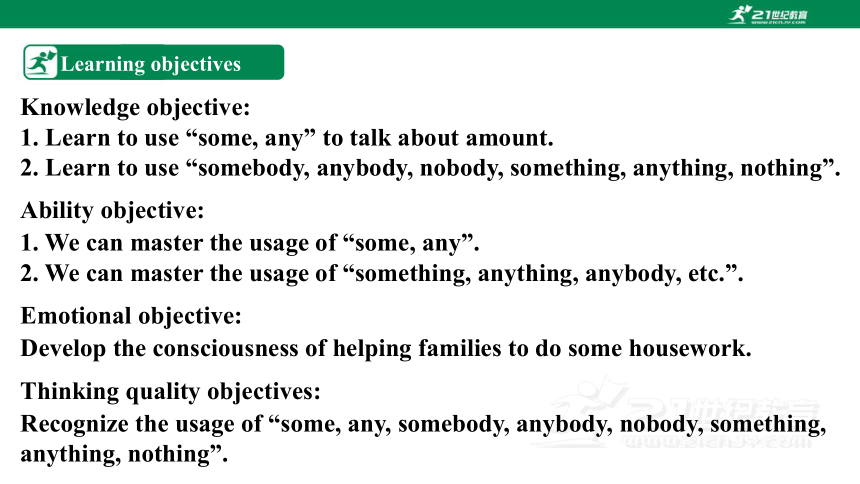
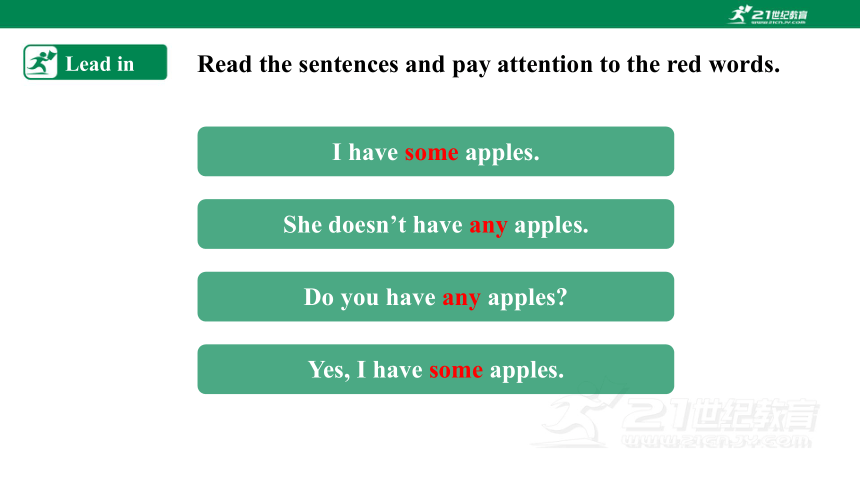
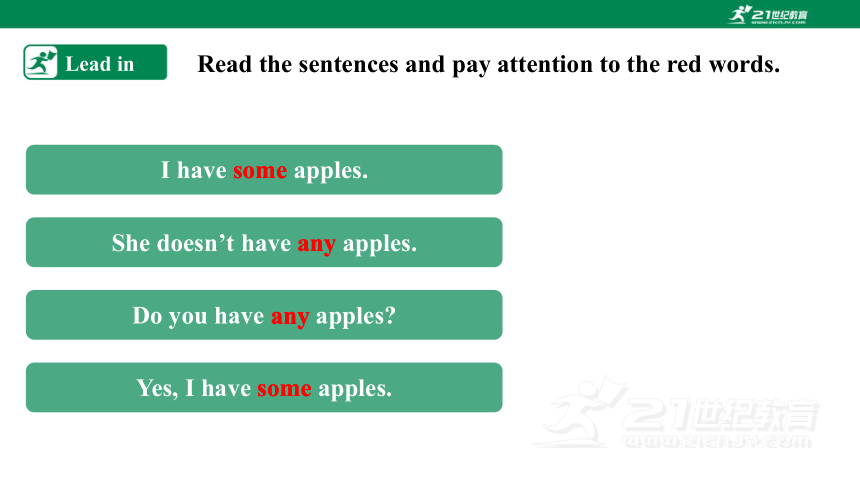

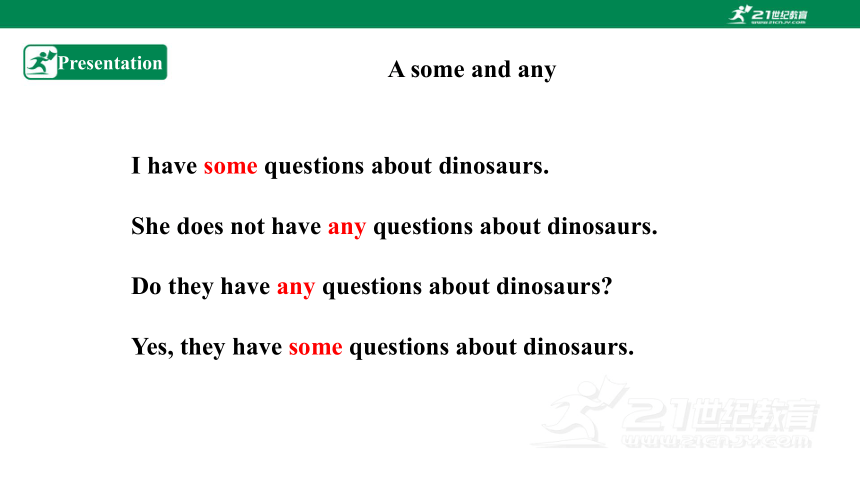
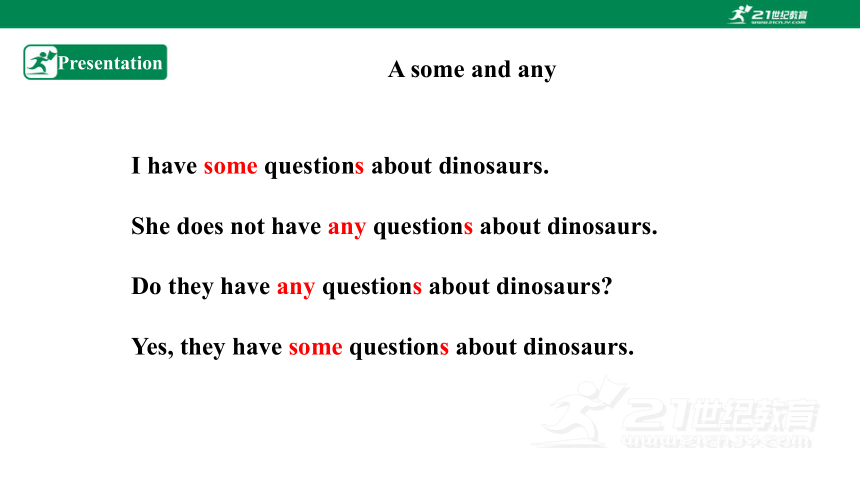
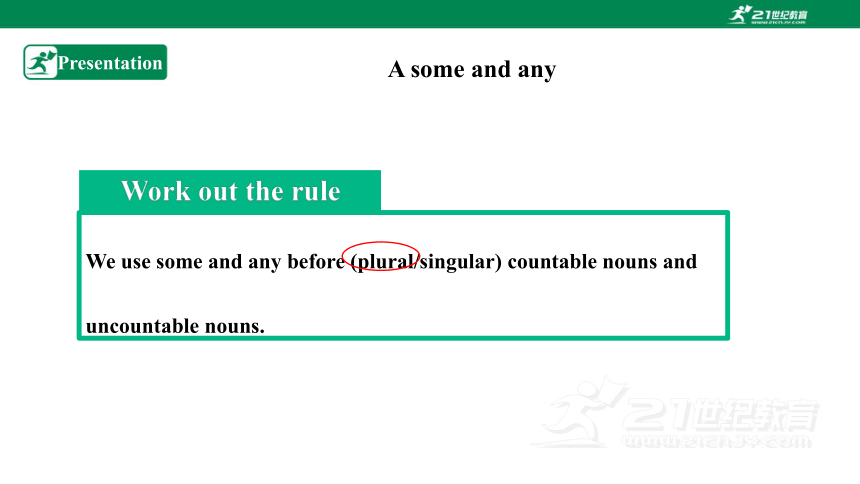
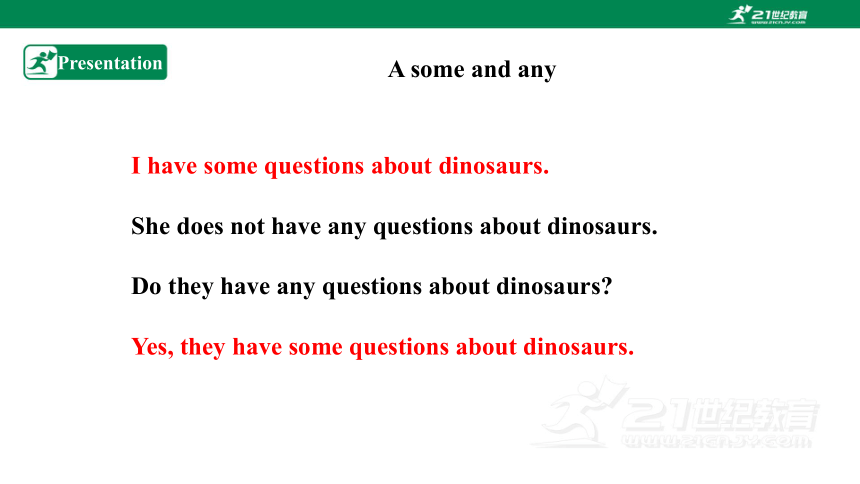
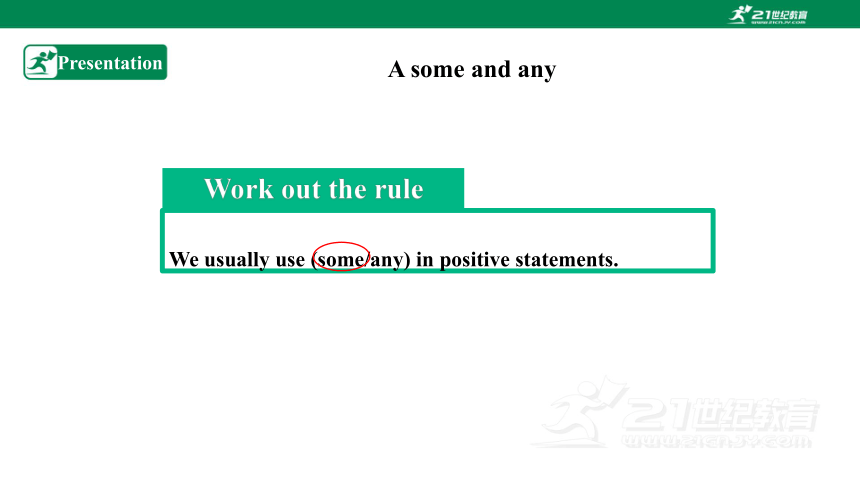
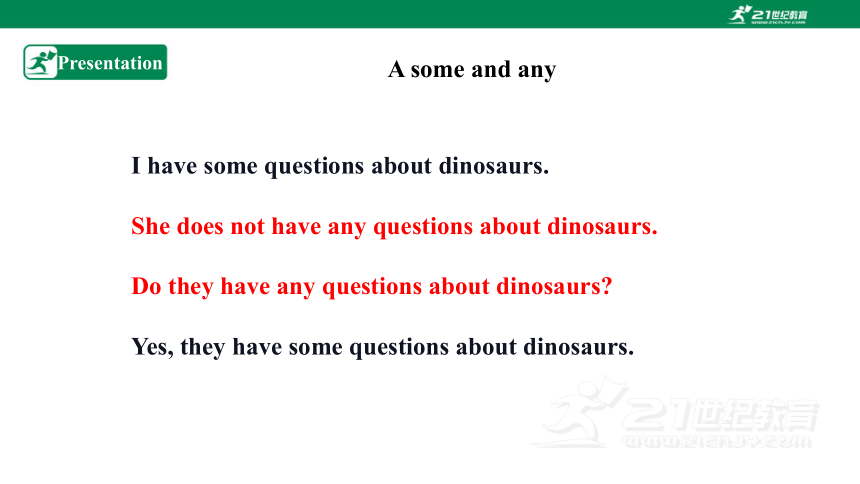
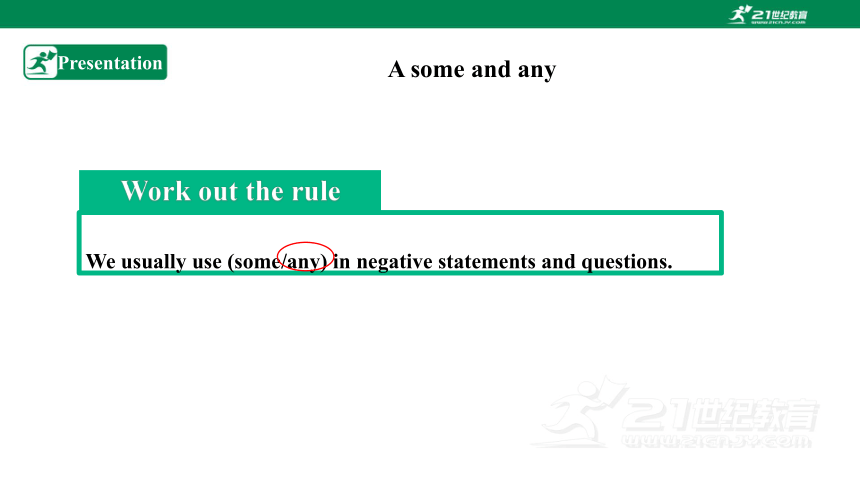
文档简介
(共49张PPT)
Unit 1 Encyclopaedias
Period 3 Grammar
牛津版 (深圳、广州、沈阳) 八年级上
Knowledge objective:
1. Learn to use “some, any” to talk about amount.
2. Learn to use “somebody, anybody, nobody, something, anything, nothing”.
Ability objective:
1. We can master the usage of “some, any”.
2. We can master the usage of “something, anything, anybody, etc.”.
Emotional objective:
Develop the consciousness of helping families to do some housework.
Thinking quality objectives:
Recognize the usage of “some, any, somebody, anybody, nobody, something, anything, nothing”.
Learning objectives
Read the sentences and pay attention to the red words.
Lead in
I have some apples.
She doesn’t have any apples.
Do you have any apples
Yes, I have some apples.
Read the sentences and pay attention to the red words.
Lead in
I have some apples.
She doesn’t have any apples.
Do you have any apples
Yes, I have some apples.
some
any
any
some
Presentation
We use some and any to talk about amounts.
数量
A some and any
Presentation
I have some questions about dinosaurs.
She does not have any questions about dinosaurs.
Do they have any questions about dinosaurs
Yes, they have some questions about dinosaurs.
A some and any
Presentation
I have some questions about dinosaurs.
She does not have any questions about dinosaurs.
Do they have any questions about dinosaurs
Yes, they have some questions about dinosaurs.
A some and any
Presentation
Work out the rule
We use some and any before (plural/singular) countable nouns and uncountable nouns.
A some and any
Presentation
I have some questions about dinosaurs.
She does not have any questions about dinosaurs.
Do they have any questions about dinosaurs
Yes, they have some questions about dinosaurs.
A some and any
Presentation
Work out the rule
We usually use (some/any) in positive statements.
A some and any
Presentation
I have some questions about dinosaurs.
She does not have any questions about dinosaurs.
Do they have any questions about dinosaurs
Yes, they have some questions about dinosaurs.
A some and any
Presentation
Work out the rule
We usually use (some/any) in negative statements and questions.
A some and any
Presentation
Can you give me some money
Would you like some more rice
Why don’t you buy some flowers for her
请求
邀请
建议
A some and any
Presentation
Work out the rule
(Some/Any) is also used in questions to show request, suggestion and invitation.
A some and any
Presentation
Would you like some ice cream
Yes, please.
A some and any
Presentation
Would you like some rice
Yes, please.
A some and any
Presentation
Things to remember
We also use (some/any) in questions when we expect the answer to be “yes”.
A some and any
Presentation
A1 Wendy and her mother are checking what food to buy. Look at the shopping list and the picture. Then ask and answer questions in pairs. Follow the example.
Presentation
Mum: Do we have any coffee
Wendy: No, we don’t have any coffee.
Mum: Do we have any noodles
Wendy: No, we don’t have any noodles.
Presentation
Mum: Do we have any milk
Wendy: Yes, we have some milk.
Mum: Do we have any eggs
Wendy: No, we don’t have any eggs.
Presentation
Mum: Do we have any orange juice
Wendy: Yes, we have some orange juice.
Mum: Do we have any potatoes
Wendy: Yes, we have some potatoes.
Presentation
A2 Later Wendy wrote a note for her plete it with some or any, and other words if necessary.
some apples
some apples
milk
orange juice
potatoes
any bread
coffee
noodles
eggs
Presentation
B somebody, anybody, nobody, etc.
I saw somebody/someone/something.
I did not see anybody/anyone/anything.
Did you see anybody/anyone/anything
I saw nobody/no one/nothing.
Presentation
B somebody, anybody, nobody, etc.
Work out the rule
We usually use (some-/ any-) in positive statements. We usually use (some-/ any-) in negative statements and questions.
Presentation
I saw somebody/someone.
I did not see anybody/anyone.
Did you see anybody/anyone
I saw nobody/no one.
somebody=
anybody=
nobody=
someone
anyone
no one
B somebody, anybody, nobody, etc.
Presentation
There is not anybody in the room.
There is nobody in the room.
We can form negative statements in two ways:
B somebody, anybody, nobody, etc.
Presentation
B somebody, anybody, nobody, etc.
I saw nobody/no one/nothing in the office.
We write no one as two words:
Presentation
B somebody, anybody, nobody, etc.
There is somebody in the room.
There is not anybody in the room.
There is nobody in the room.
Somebody is here.
Is anybody here
Nobody is here.
Somebody, anybody,nobody etc. are singular.
Presentation
Look at the picture below for one minute. Try to remember where everything and everybody is. Then cover the picture and ask and answer questions in pairs. Follow the examples.
Presentation
Look at the picture below for one minute. Try to remember where everything and everybody is. Then cover the picture and ask and answer questions in pairs. Follow the examples.
1.Is there anything on the blackboard
S1: Is there anything on the blackboard
S2: No, there's nothing/there isn't anything on the blackboard.
Presentation
Look at the picture below for one minute. Try to remember where everything and everybody is. Then cover the picture and ask and answer questions in pairs. Follow the examples.
2.Is there anything on the noticeboard
S1: Is there anything on the noticeboard
S2: Yes, there's something on the noticeboard.
Presentation
Look at the picture below for one minute. Try to remember where everything and everybody is. Then cover the picture and ask and answer questions in pairs. Follow the examples.
3.Is there anything above the teacher
S1: Is there anything above the teacher
S2: No, there's nothing/there isn't anything above the teacher.
Presentation
Look at the picture below for one minute. Try to remember where everything and everybody is. Then cover the picture and ask and answer questions in pairs. Follow the examples.
4.Is there anybody by the window
S1: Is there anybody by the window
S2: Yes, there's somebody by the window.
Presentation
Look at the picture below for one minute. Try to remember where everything and everybody is. Then cover the picture and ask and answer questions in pairs. Follow the examples.
5.Is there anything under the teacher's desk
S1: Is there anything under the teacher's desk
S2: No, there's nothing/there isn't anything under the teacher's desk.
Presentation
Look at the picture below for one minute. Try to remember where everything and everybody is. Then cover the picture and ask and answer questions in pairs. Follow the examples.
6.Is there anyone behind the teacher
S1: Is there anyone behind the teacher
S2: Yes, there's someone behind the teacher.
Presentation
Look at the picture below for one minute. Try to remember where everything and everybody is. Then cover the picture and ask and answer questions in pairs. Follow the examples.
7.Is there anything on the bookcase
S1: Is there anything on the bookcase
S2: No, there's something on the bookcase.
Presentation
Look at the picture below for one minute. Try to remember where everything and everybody is. Then cover the picture and ask and answer questions in pairs. Follow the examples.
8.Is there anyone next to the piano
S1: Is there anyone next to the piano
S2: Yes, there's someone next to the piano.
Pair work
Look at the picture and then ask and answer questions with your partner.
Pair work
Look at the picture and then ask and answer questions with your partner.
Is there any bread in the fridge
Yes, there is some bred in the fridge.
Pair work
Look at the picture and then ask and answer questions with your partner.
Are there any tomatoes in the fridge
Yes, there are some tomatoes in the fridge.
Pair work
Look at the picture and then ask and answer questions with your partner.
Is there any milk in the fridge
No, there isn’t any milk in the fridge.
Pair work
Look at the picture and then ask and answer questions with your partner.
Are there any eggs in the fridge
No, there aren’t any eggs in the fridge.
用some, any 填空。
Exercise
People can see _________ dinosaur fossils in the museum.
Can people get _________ information about dinosaurs from their fossils
We can’t see __________ living dinosaurs on Earth now.
Would you like to give _________ advice to our park
some
any
any
some
Exercise
Fill in the blanks with some, anything, everything, anybody, everyone, no one.
Dear Tom,
How was your vacation Did you do _________ interesting Did __________ go with you I went to a museum with my family. __________ was great. I took _________photos. _________ in the museum was kind to us. We all had a great time at the museum. ________ was unhappy for the visiting. How about you
Wendy
anything
anybody
Everything
some
Everyone
No one
Summary
1. some + [C]pl./ n. [U];any + [C]pl./ n. [U]
2. “Some/ some-” used in positive sentences.
“Any /any-” used in negative sentences or questions.
3. “Some” used in questions to show request, suggestion and invitation or expect a positive answer.
Homework
1. Review the usage of “some, any, something, anything, nothing, somebody, anybody, nobody”.
2. Practise using “some, any, something, anything, nothing, somebody, anybody, nobody” in daily life.
Reflection
Everyone you meet is afraid of something, loves something, and has lost something.
https://www.21cnjy.com/help/help_extract.php
Unit 1 Encyclopaedias
Period 3 Grammar
牛津版 (深圳、广州、沈阳) 八年级上
Knowledge objective:
1. Learn to use “some, any” to talk about amount.
2. Learn to use “somebody, anybody, nobody, something, anything, nothing”.
Ability objective:
1. We can master the usage of “some, any”.
2. We can master the usage of “something, anything, anybody, etc.”.
Emotional objective:
Develop the consciousness of helping families to do some housework.
Thinking quality objectives:
Recognize the usage of “some, any, somebody, anybody, nobody, something, anything, nothing”.
Learning objectives
Read the sentences and pay attention to the red words.
Lead in
I have some apples.
She doesn’t have any apples.
Do you have any apples
Yes, I have some apples.
Read the sentences and pay attention to the red words.
Lead in
I have some apples.
She doesn’t have any apples.
Do you have any apples
Yes, I have some apples.
some
any
any
some
Presentation
We use some and any to talk about amounts.
数量
A some and any
Presentation
I have some questions about dinosaurs.
She does not have any questions about dinosaurs.
Do they have any questions about dinosaurs
Yes, they have some questions about dinosaurs.
A some and any
Presentation
I have some questions about dinosaurs.
She does not have any questions about dinosaurs.
Do they have any questions about dinosaurs
Yes, they have some questions about dinosaurs.
A some and any
Presentation
Work out the rule
We use some and any before (plural/singular) countable nouns and uncountable nouns.
A some and any
Presentation
I have some questions about dinosaurs.
She does not have any questions about dinosaurs.
Do they have any questions about dinosaurs
Yes, they have some questions about dinosaurs.
A some and any
Presentation
Work out the rule
We usually use (some/any) in positive statements.
A some and any
Presentation
I have some questions about dinosaurs.
She does not have any questions about dinosaurs.
Do they have any questions about dinosaurs
Yes, they have some questions about dinosaurs.
A some and any
Presentation
Work out the rule
We usually use (some/any) in negative statements and questions.
A some and any
Presentation
Can you give me some money
Would you like some more rice
Why don’t you buy some flowers for her
请求
邀请
建议
A some and any
Presentation
Work out the rule
(Some/Any) is also used in questions to show request, suggestion and invitation.
A some and any
Presentation
Would you like some ice cream
Yes, please.
A some and any
Presentation
Would you like some rice
Yes, please.
A some and any
Presentation
Things to remember
We also use (some/any) in questions when we expect the answer to be “yes”.
A some and any
Presentation
A1 Wendy and her mother are checking what food to buy. Look at the shopping list and the picture. Then ask and answer questions in pairs. Follow the example.
Presentation
Mum: Do we have any coffee
Wendy: No, we don’t have any coffee.
Mum: Do we have any noodles
Wendy: No, we don’t have any noodles.
Presentation
Mum: Do we have any milk
Wendy: Yes, we have some milk.
Mum: Do we have any eggs
Wendy: No, we don’t have any eggs.
Presentation
Mum: Do we have any orange juice
Wendy: Yes, we have some orange juice.
Mum: Do we have any potatoes
Wendy: Yes, we have some potatoes.
Presentation
A2 Later Wendy wrote a note for her plete it with some or any, and other words if necessary.
some apples
some apples
milk
orange juice
potatoes
any bread
coffee
noodles
eggs
Presentation
B somebody, anybody, nobody, etc.
I saw somebody/someone/something.
I did not see anybody/anyone/anything.
Did you see anybody/anyone/anything
I saw nobody/no one/nothing.
Presentation
B somebody, anybody, nobody, etc.
Work out the rule
We usually use (some-/ any-) in positive statements. We usually use (some-/ any-) in negative statements and questions.
Presentation
I saw somebody/someone.
I did not see anybody/anyone.
Did you see anybody/anyone
I saw nobody/no one.
somebody=
anybody=
nobody=
someone
anyone
no one
B somebody, anybody, nobody, etc.
Presentation
There is not anybody in the room.
There is nobody in the room.
We can form negative statements in two ways:
B somebody, anybody, nobody, etc.
Presentation
B somebody, anybody, nobody, etc.
I saw nobody/no one/nothing in the office.
We write no one as two words:
Presentation
B somebody, anybody, nobody, etc.
There is somebody in the room.
There is not anybody in the room.
There is nobody in the room.
Somebody is here.
Is anybody here
Nobody is here.
Somebody, anybody,nobody etc. are singular.
Presentation
Look at the picture below for one minute. Try to remember where everything and everybody is. Then cover the picture and ask and answer questions in pairs. Follow the examples.
Presentation
Look at the picture below for one minute. Try to remember where everything and everybody is. Then cover the picture and ask and answer questions in pairs. Follow the examples.
1.Is there anything on the blackboard
S1: Is there anything on the blackboard
S2: No, there's nothing/there isn't anything on the blackboard.
Presentation
Look at the picture below for one minute. Try to remember where everything and everybody is. Then cover the picture and ask and answer questions in pairs. Follow the examples.
2.Is there anything on the noticeboard
S1: Is there anything on the noticeboard
S2: Yes, there's something on the noticeboard.
Presentation
Look at the picture below for one minute. Try to remember where everything and everybody is. Then cover the picture and ask and answer questions in pairs. Follow the examples.
3.Is there anything above the teacher
S1: Is there anything above the teacher
S2: No, there's nothing/there isn't anything above the teacher.
Presentation
Look at the picture below for one minute. Try to remember where everything and everybody is. Then cover the picture and ask and answer questions in pairs. Follow the examples.
4.Is there anybody by the window
S1: Is there anybody by the window
S2: Yes, there's somebody by the window.
Presentation
Look at the picture below for one minute. Try to remember where everything and everybody is. Then cover the picture and ask and answer questions in pairs. Follow the examples.
5.Is there anything under the teacher's desk
S1: Is there anything under the teacher's desk
S2: No, there's nothing/there isn't anything under the teacher's desk.
Presentation
Look at the picture below for one minute. Try to remember where everything and everybody is. Then cover the picture and ask and answer questions in pairs. Follow the examples.
6.Is there anyone behind the teacher
S1: Is there anyone behind the teacher
S2: Yes, there's someone behind the teacher.
Presentation
Look at the picture below for one minute. Try to remember where everything and everybody is. Then cover the picture and ask and answer questions in pairs. Follow the examples.
7.Is there anything on the bookcase
S1: Is there anything on the bookcase
S2: No, there's something on the bookcase.
Presentation
Look at the picture below for one minute. Try to remember where everything and everybody is. Then cover the picture and ask and answer questions in pairs. Follow the examples.
8.Is there anyone next to the piano
S1: Is there anyone next to the piano
S2: Yes, there's someone next to the piano.
Pair work
Look at the picture and then ask and answer questions with your partner.
Pair work
Look at the picture and then ask and answer questions with your partner.
Is there any bread in the fridge
Yes, there is some bred in the fridge.
Pair work
Look at the picture and then ask and answer questions with your partner.
Are there any tomatoes in the fridge
Yes, there are some tomatoes in the fridge.
Pair work
Look at the picture and then ask and answer questions with your partner.
Is there any milk in the fridge
No, there isn’t any milk in the fridge.
Pair work
Look at the picture and then ask and answer questions with your partner.
Are there any eggs in the fridge
No, there aren’t any eggs in the fridge.
用some, any 填空。
Exercise
People can see _________ dinosaur fossils in the museum.
Can people get _________ information about dinosaurs from their fossils
We can’t see __________ living dinosaurs on Earth now.
Would you like to give _________ advice to our park
some
any
any
some
Exercise
Fill in the blanks with some, anything, everything, anybody, everyone, no one.
Dear Tom,
How was your vacation Did you do _________ interesting Did __________ go with you I went to a museum with my family. __________ was great. I took _________photos. _________ in the museum was kind to us. We all had a great time at the museum. ________ was unhappy for the visiting. How about you
Wendy
anything
anybody
Everything
some
Everyone
No one
Summary
1. some + [C]pl./ n. [U];any + [C]pl./ n. [U]
2. “Some/ some-” used in positive sentences.
“Any /any-” used in negative sentences or questions.
3. “Some” used in questions to show request, suggestion and invitation or expect a positive answer.
Homework
1. Review the usage of “some, any, something, anything, nothing, somebody, anybody, nobody”.
2. Practise using “some, any, something, anything, nothing, somebody, anybody, nobody” in daily life.
Reflection
Everyone you meet is afraid of something, loves something, and has lost something.
https://www.21cnjy.com/help/help_extract.php
